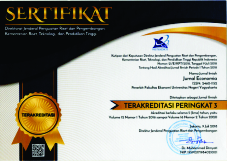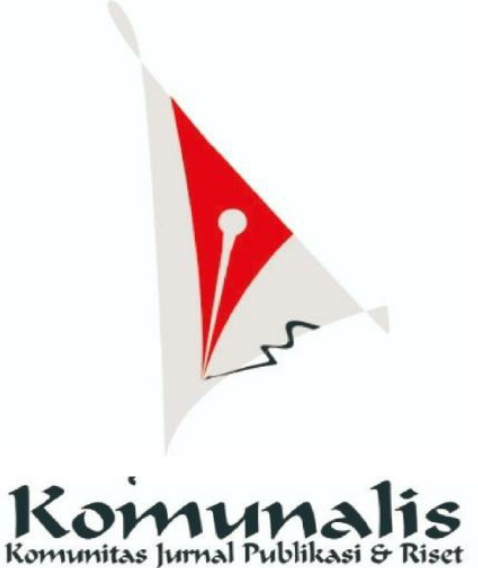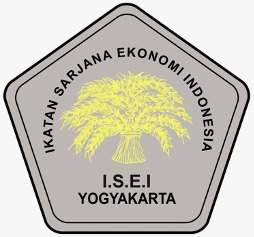The Impact of Using DME as a Substitute for LPG in Indonesian Economy
Downloads
Abstract
In order to reduce the import ratio and high budget needs for energy subsidies, the government of Indonesia is currently developing DME production to replace LPG as fuel in cooking activities. From various previous studies, the policy of using DME not only requires a relatively expensive cost but also has the potential to disrupt health and endanger environmental sustainability due to the use of large amounts of fossil energy from coal. This study aims to examine the impacts of DME policy on the Indonesian economy using the CGE method, 2019 SAM data and two forms of shocks: (i) Decreasing LPG imports and (ii) Reallocating the subsidies budget. DME will have a positive impact on the economy, trigger growth in the productivity of various sectors and encourage employment, but only in the short run. The results of the study in the long run show negative implications even though the percentages are relatively low and not significant.
Keywords: CGE, DME, Energy Subsidies, Import, LPG
Downloads
Abdullahi, A. O., Safiyanu, S. S., & Soja, T. (2016). International Trade And Economic Growth: An Empirical Analysis Of West Africa. IOSR Journal of Economics and Finance, 7, 12–15.
Ackerman, F., & Stanton, E. A. (2012). Climate risks and carbon prices: Revising the social cost of carbon. Economics, 6.
Aissa, N., & Hartono, D. (2016). The Impact Of Geothermal Energy Sector Development On Electricity Sector In Indonesia Economy. In Buletin Ekonomi Moneter dan Perbankan (Vol. 19, Issue 2).
Aissa, N., & Hartono, D. (2017). The Impact Of Geothermal Energy Sector Development On Electricity Sector In Indonesia Economy. Bulletin of Monetary Economics and Banking, 19(2).
Aksi Ekologi & Emansipasi Rakyat. (2020). Coal Downstreaming in the Form of Dimethyl Ether (DME) Will Increase Greenhouse Gas Emissions.
Alam, M. M., Uddin, M. G. S., & Taufique, K. M. R. (2009). Import Inflows of Bangladesh: the Gravity Model Approach. International Journal of Economics and Finance, 1(1).
Ansari, M. I. (1993). Testing the Relationship Between Government Expenditure and National Income in Canada, Employing Granger Causality and Cointegration Analysis. In Managerial Finance (Vol. 19).
Astuti, I. P., & Ayuningtyas, F. J. (2018). Pengaruh Ekspor Dan Impor Terhadap Pertumbuhan Ekonomi Di Indonesia. Jurnal Ekonomi & Studi Pembangunan, 19(1).
Bakari, S. (2017). The Three-Way Linkages Between Export, Import and Economic Growth: New Evidence From Tunisia (Vol. 2, Issue 3). www.jseg.ro
Barro, R. J. (1990). Government Spending in a Simple Model of Endogeneous Growth. Journal of Political Economy, 98(5, Part 2), S103–S125.
Boedoyo, M. S. (2016). Pemanfaatan Dimethyl Ether (Dme) Sebagai Substitusi Bahan Bakar Minyak Dan Lpg. Jurnal Teknologi Lingkungan, 11(2), 301.
BP Energy. (2021). Statistical Review of World Energy 2021. BP Energy Outlook 2021, 70, 8–20.
Branson, W. H. (1979). Macroeconomic Theory and Policy.
Bridle, R., Sharma, S., Mostafa, M., & Geddes, A. (2019). Fossil Fuel to Clean Energy Subsidy Swaps: How to pay for an energy revolution GSI Report.
Esdm.go.id (2017, 13 September). Reformasi Subsidi Energi: Belanja Jadi Lebih Produktif. Diakses pada 14 Mei 2022 dari https://migas.esdm.go.id/post/read/reformasi-subsidi-energi--belanja-jadi-lebih-produktif
Farajzadeh, Z., & Bakhshoodeh, M. (2015). Economic and environmental analyses of Iranian energy subsidy reform using Computable General Equilibrium (CGE) model. Energy for Sustainable Development, 27, 147–154.
Filippov, S. P., & Keiko, A. V. (2021). Coal Gasification: At the Crossroads. Economic Outlook. Thermal Engineering , 68(5), 347–360.
GGGI. (2020). Employment assessment of renewable energy: Indonesian power sector pathways. http://greengrowth.bappenas.go.id/wp-content/uploads/2020/07/Employment-assessment-of-renewable-energy-Indonesian-power-sector-pathways-NEAR-NDC.pdf
Hartono, D., Purwanto, W. W., Nurkholis, & Rum, I. A. (2017). Impact analysis of natural gas policy in Indonesia. Energy Sources, Part B: Economics, Planning and Policy,12(8), 699–706.
Hartono, D., & Resosudarmo, B. (2006). The Economy-wide Impact of Fuel Oil, Gas and Electricity Pricing and Subsidy Policies as well as Their Consumption Improvement Efficiency in Indonesia.
Hayati, M. (2013). Pemahaman dasar analisis model computable general equilibrium (CGE). Agriekonomika, 2(2013), 66–75.
Henseler, M., & Maisonnave, H. (2018). Low world oil prices: A chance to reform fuel subsidies and promote public transport? A case study for South Africa. Transportation Research Part A: Policy and Practice, 108, 45–62.
Hodijah, S., Patricia Angelina, G., Ekonomi dan Bisnis, F., & Jambi, U. (2021). Analisis Pengaruh Ekspor dan Impor Terhadap Pertumbuhan Ekonomi Di Indonesia. Jurnal Manajemen Terapan Dan Keuangan (Mankeu), 10(01).
Hutagalung, A. M., Hartono, D., Arentsen, M. J., & Lovett, J. C. (2020). The economic implications of natural gas pricing adjustment in Indonesia. International Energy Journal, 20(2), 129–140.
IEA. (2021). World Energy Outlook 2021. www.iea.org/weo
IMF. (2015). Consultation-Staff Report; Press Release; and Statement By The Executive Director For Malaysia. http://www.imf.org
Kajian, P., & Keahlian, A. B. (2020). Analisis Ringkas Cepat: Subsidi Gas LPG Tabung 3 Kg.
Kemenkeu.go.id (2020). Kajian: Kebijakan Subsidi LPG Tabung 3 kg Tepat Sasaran. Diakses pada 13 Mei 2022, dari https://fiskal.kemenkeu.go.id/kajian/2020/07/06/093356342653278-kajian-kebijakan-subsidi-lpg-tabung-3kg-tepat-sasaran
Kementerian ESDM RI. (2021). Handbook of Energy & Economy Statistics of Indonesia 2020. Book, 1–111.
Kementerian Keuangan. (2021). Informasi APBN 2021. Kementerian Keuangan Direktorat Jenderal Anggaran, 1–48..
Kim, E., & Samudro, Y. N. (2021). Reducing Fuel Subsidies and Financing Road Infrastructure in Indonesia: A Financial Computable General Equilibrium Model. Bulletin of Indonesian Economic Studies, 57(1), 111–133.
Kweka, J. P., & Morrissey, O. (2000). Government Spending and Economic Growth in Tanzania, 1965-1996.
Larson, E. D., & Yang, H. (2004). Dimethyl ether (DME) from coal as a household cooking fuel in China. Energy for Sustainable Development, 8(3), 115–126.
Lee, J., Kim, H., & Rhee, D. E. (2021). No harmless child labor: The effect of child labor on academic achievement in francophone Western and Central Africa. International Journal of Educational Development, 80(July 2020), 102308.
LevaÄić, R., & Rebmann, A. (1982). Macroeconomics. Macmillan Education UK.
Li, Y., Shi, X., & Su, B. (2017). Economic, social and environmental impacts of fuel subsidies: A revisit of Malaysia. Energy Policy, 110(167), 51–61.
Lucas, R. E. (1988). On The Mechanics of Economic Development. Journal of Monetary Economics, 22, 3–42.
Murti, G. W., Priyanto, U., Masfuri, I., & Adelia, N. (2021a). the Effect of Dimethyl Ether (Dme) As Lpg Substitution on Household Stove: Mixture Stability, Stove Efficiency, Fuel Consumption, and Materials Testing. Majalah Ilmiah Pengkajian Industri, 15(2), 77–86.
Murti, G. W., Priyanto, U., Masfuri, I., & Adelia, N. (2021b). The Effect of Dimethyl Ether (DME) As LPG Substitution on Household Stove: Mixture Stability, Stove Efficiency, Fuel Consumption, and Materials Testing. Open Journal System BPPT, 15(2), 77–86.
Nugroho, A., & Amir, H. (2018). Analisis Dampak Insentif Fiskal Penetapan Harga Gas Bagi Industri Domestik Terhadap Perekonomian: Pendekatan Model CGE Dinamis (Vol.2, Issue 1).
Permata, I. M., Prasmuko, A., & Yanfitri. (2010). The Labor Shifting in Indonesia Labor Market.
Ptba.co.id. (2020, 11 November). Hemat Devisa, Peningkatan Nilai Tambah Batu Bara & Ketahanan Energi Nasional, Inilah Sejumlah Manfaat Gasifikasi Batu Bara untuk Indonesia. Diakses pada 12 Februari 2022, dari https://ptba.co.id/berita/hemat-devisa-peningkatan-nilai-tambah-batu-bara-ketahanan-energi-nasional-inilah-sejumlah-manfaat-gasifikasi-batu-bara-untuk-indonesia-1303
Ptba.co.id. (2021, 11 Mei). Proyek Gasifikasi Batu Bara Guna Pangkas Impor LPG, Kembangkan Green Economy, dan Bawa Investasi ke Indonesia. Diakses pada 14 Februari 2022, dari https://ptba.co.id/berita/proyek-gasifikasi-batu-bara-guna-pangkas-impor-lpg-kembangkan-green-economy-dan-bawa-investasi-ke-indonesia-1360
Resosudarmo, B. P., Yusuf, A. A., Barat, J., Hartono, D., Barat, J., & Nurdianto, D. A. (2011). Regional Economic Modelling for Indonesia: Implementation of IRSA-Indonesia 5. Journal of Indonesian Economy and Business, 26(3), 287–309.
Resosudarmo, B. P., Yusuf, A. A., Hartono, D., & Nurdianto, D. A. (2011). Regional Economic Modelling for Indonesia: Implementation of IRSA-Indonesia 5. In Journal of Indonesian Economy and Business (Vol. 26, Issue 3).
Romer, P. M. (1990). Endogenous Technological Change.
Samawi, G. A., Mdanat, M. F., & Arabiyat, T. S. (2017). International Journal of Energy Economics and Policy The Role of Energy Supply in Economic Growth: Evidence from the Oil Importing Countries. International Journal of Energy Economics and Policy,7(6),193–200.
Sarrakh, R., Renukappa, S., Suresh, S., & Mushatat, S. (2020). Impact of subsidy reform on the kingdom of Saudi Arabia's economy and carbon emissions. Energy Strategy Reviews, 28.
Sobri, A. R., Hartono, D., & Lestari, N. I. (2020). Energy efficiency, rebound effect and environmental tax reform in Indonesia Energy efficiency, rebound effect and environmental tax reform in Indonesia 137. In Int. J. Energy Technology and Policy (Vol. 16, Issue 2).
TNP2K. (2021). Policy Paper (Naskah Kebijakan) Reformasi Kebijakan Subsidi LPG Tepat Sasaran: Mengurangi Kesenjangan dan Menjamin Pemerataan. www.tnp2k.go.id
Torasa, C., & Mekhum, W. (2020). Analyzing the impact of energy imports, fuel substitution and technological change on real GDP: A panel data study of asean countries. International Journal of Energy Economics and Policy, 10(6), 559–565.
Tumiwa, Fabby, Laan, Tara, Lang, Kerryn, Vis-Dunbar, & Damon. (2012). A Citizens' Guide To Energy Subsidies In Indonesia. https://www.iisd.org/publications/report/citizens-guide-energy-subsidies-indonesia-update
Winardi, W. (2014). Dampak Pembatasan Impor Hortikultura Terhadap Aktivitas Perekonomian, Tingkat Harga dan Kesejahteraan. https://doi.org/https://doi.org/10.21098/bemp.v16i1.36















